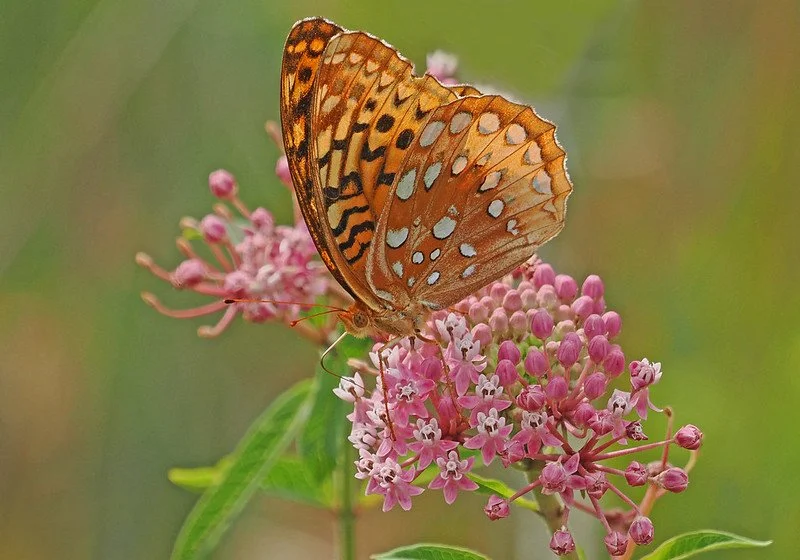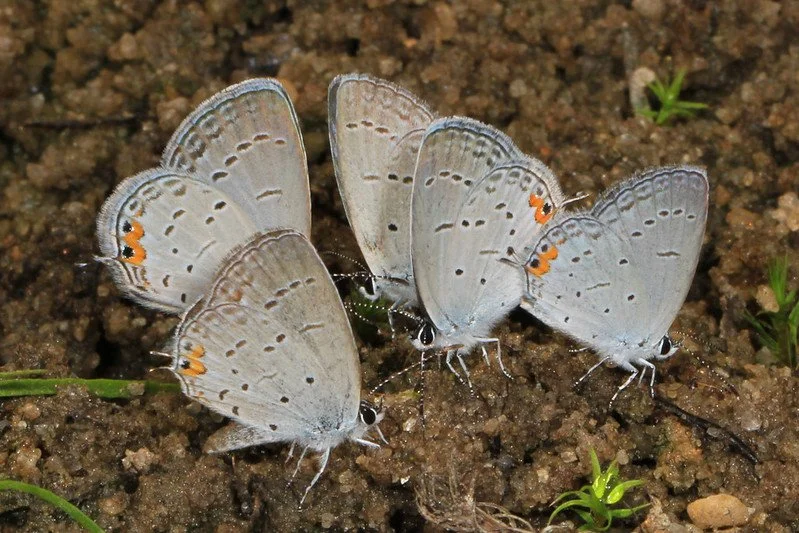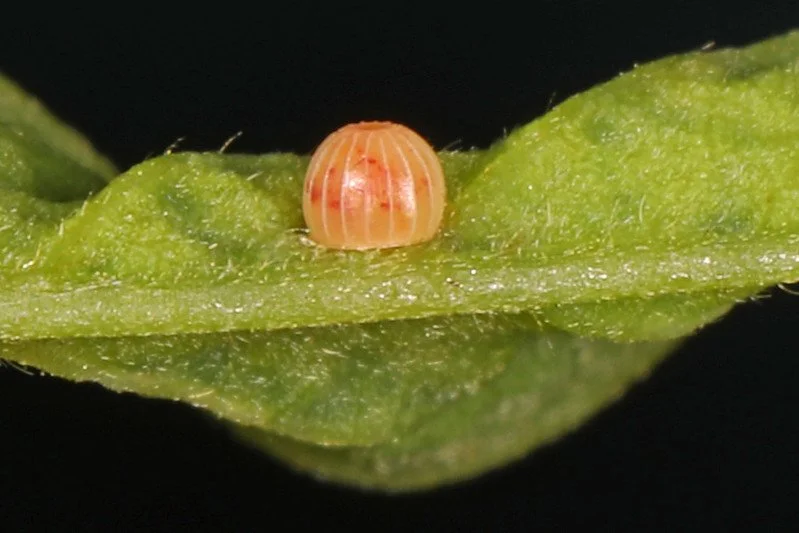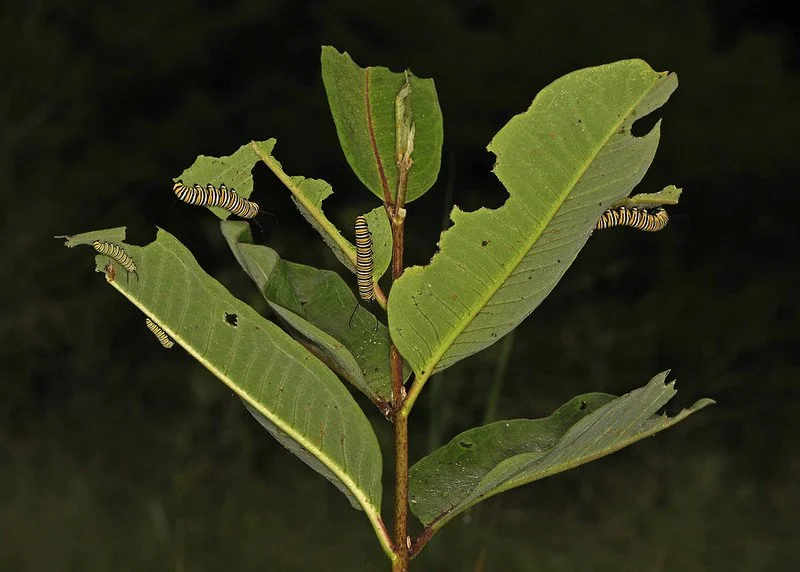Photo: Monarch butterfly nectaring on a thistle, Judy Gallagher
Cliff Fairweather
Do you want more butterflies around your home? Consider creating a butterfly habitat that will attract not just adult butterflies passing through but will support butterflies throughout their life cycles. A habitat is where a living thing finds what it needs for survival: food, water, shelter, and space. Butterflies undergo a four-stage metamorphosis, which includes egg, caterpillar (larva), chrysalis (pupa), and adult. The specific habitat needs of butterflies change as they go through their life cycles, so the challenge in creating butterfly habitat is to meet their needs in each stage.
Tiger Swallowtails, Virginia’s state insect, nectaring on buttonbush. Photo: Judy Gallagher
Adult butterflies need high-energy fuel for activities such as flight, foraging, mating, and egg laying, and that fuel is flower nectar. Nectar is essentially sugar water produced by flowers to attract pollinators. Butterflies seek it from a wide variety of herbaceous and woody flowering plants. They are opportunistic feeders, mostly without strong preferences for particular species of nectar flowers. They do have preferences, however, for particular flower characteristics. Butterflies have good color vision and are attracted to flowers with bright colors, especially yellow, orange, white, pink, red, and blue. They also are attracted to flowers with floral scents and flowers rich in nectar.
Flower shape and the arrangement of flowers on a plant influence which nectar plants butterflies choose. They strongly favor flowers with tubular corollas, such as phloxes, which accommodate a butterfly’s long, thin proboscis. Because different butterflies have proboscises of different lengths, plant flowers with a variety of corolla lengths to attract a wider diversity of butterflies.
Nectar plants with clusters of many small flowers offer efficient nectaring for butterflies, such as this Great Spangled Fritillary. Photo: Judy Gallagher.
Butterflies tend to prefer plants with loose clusters of smaller flowers, like milkweeds, or tight clusters of small to tiny flowers, like asters. Clustered flowers offer efficient nectaring opportunities, enabling butterflies to visit many flowers quickly with a minimum of flying. Butterflies also tend to select flowers, such as sunflowers and asters, that provide a relatively flat, stable landing place. This allows them to rest while they feed.
Most native plants have relatively short blooming periods, so try to offer a diverse mix of nectar plants with varied blooming times to ensure that something is blooming throughout the growing season. This bloom time table from Plant NoVA Natives is a good reference. Different butterfly species often forage at different heights, so offering plants of various heights can draw more butterfly diversity. Avoid cultivars of native species, because they might have undesirable characteristics, such as not producing nectar or producing nectar that is difficult to access. This document lists some examples of nectar plants native to northern Virginia, but there are many others. Consult your local native plant society chapter, butterfly club, naturalist organization, native plant vendors, or nature center for more choices.
Massing nectar plants of the same species together, rather than spreading them out, will create beacons for foraging butterflies. Plant taller plants towards the back and shorter plants in front of them so they aren’t hidden from view. If you have space, place trees and shrubs to shield nectar plants from the prevailing winds, making it easier for foraging butterflies to nectar on windy days. These also provide butterfly perching, roosting, basking, and sheltering sites.
Nectar and host plants alone don’t provide all the nutrients butterflies need. Most also need nutrients such as amino acids, nitrogen, and sodium. These are especially important for reproductive success. To obtain these, they engage in a behavior called puddling, where they land on patches of damp soil or sand, often at the edge of water puddles. They use their proboscises to imbibe nutrients from the wet spot.
Butterfly adults, mostly males, visit damp soil or sand to imbibe nutrients not available in nectar. These are Eastern-tailed Blues. Photo: Judy Gallagher
You can create a puddling site by creating a patch of bare soil or sand in a flat, sunny spot in your habitat that you can wet down every day or so. Puddling sites also can be an important source of water for butterflies. Some butterflies seek additional nutrients from animal dung and carrion. Some also feed on rotted fruit, so putting some out in your habitat, or leaving some fallen fruit from trees, might attract some additional species.
Silver-spotted Skipper egg on a Black Locust leaf: providing habitat for the entire butterfly life cycle will result in more butterflies using your habitat. Photo: Judy Gallagher.
While nectar plants fuel adult butterflies, caterpillars need something more substantial to nourish their enormous and rapid growth to as much as 100 times their size at hatching. To satisfy the appetites of their progeny, female butterflies search out host plants on which to lay their eggs. Not just any plant will do as a host, it must be a plant that their species is adapted to eat. Most plants produce toxins and other defenses to deter insects from eating them. Caterpillars evolve tolerances for or countermeasures against these defenses, giving them nearly exclusive access to their host plants as a food source. Because different plants have evolved different defenses, caterpillars usually specialize in a few species of host plants.
To help decide what host plants to grow, learn what species of butterflies are likely to be found in your area. Of course, you’ll also need to take into consideration the growing conditions on your site. Host plants include many woody, as well as herbaceous, forms. Many, such as milkweed, do double duty as nectar plants. This document includes a table of butterfly species and their host plants. Butterfly field guides usually list host plants for each species they cover. Also, remember that because the purpose of planting host plants in your habitat is to feed caterpillars, you need to tolerate some damage to host plant foliage. That damage, though, is a sign of success – it means you’re raising caterpillars!
Monarch butterfly caterpillars feeding on Common Milkweed. Creating butterfly habitat means tolerating some damage to host plants. Photo: Judy Gallagher.
Monarch Butterfly chrysalis: Chrysalises need an undisturbed place in your habitat to transform from caterpillar to adult. Photo: Judy Gallagher.
When they are ready to metamorphose into their pupal stage, caterpillars usually leave their host plant, but they don’t go far. Many species suspend their chrysalises from a plant, branch, or other structure, natural or human-made, while others pupate under leaf litter or in the soil. To support butterflies in their egg, caterpillar, and chrysalis stage, avoid being an overly tidy gardener. Leave leaf litter on the ground, as some butterflies, many moths, and other beneficial insects pupate in the fallen leaves. Also, resist the urge to do a late winter or early spring cleanup by removing last year’s dead vegetation, at least until temperatures have warmed for a while and overwintering eggs, caterpillars and chrysalises have had a chance to move on to their next stage.
Beyond food and nutrients, butterflies need places to bask in the sun, find shelter from storms and predators, spend the night, hibernate, and perch. A large rock or steppingstone placed in a sunny spot can provide a basking site where butterflies can warm their flight muscles up to flying temperature. They also will use large leaves as basking sites. The underside of leaves can provide a shelter against rain, a hiding place from predators, or a place to spend the night. Tree cavities, loose bark, or even old bird houses can provide short-term shelters or hibernation sites for overwintering butterfly adults and chrysalises. Some male butterflies use rocks, shrubs, or trees as perches from which to watch for potential mates and rivals.
Monarch Butterfly nectaring on a thistle. Photo: Judy Gallagher.
Planning and managing your butterfly habitat needn’t be complicated, but there are some basic things you should consider. First of these is where to locate the habitat. Monitor your property to see if butterflies are already visiting and where they linger. Also, look for any existing native nectar or host plants. Butterflies are “cold blooded,” so select an area that gets sun for at least six to eight hours a day. The space needn’t be large, just enough room for some host and nectar plants and some other habitat elements. Even a patio or balcony can provide some habitat with container-grown plants
Once established, a butterfly habitat should be fairly low maintenance, but it is not maintenance-free. You will need to manage invasive exotic plants and thin out natives that are trying to take over. Pesticide use is incompatible with raising caterpillars, so consider non-toxic alternatives to pest control, including just waiting out infestations. Often, a predator or parasite will come along and handle the problem.
Creating a butterfly habitat will do more than provide a home for butterflies. Other wildlife, from fireflies to songbirds, will use your habitat as well, and you will be making a valuable contribution to local biological diversity. Also, it’s just plain fun to have butterflies around!
Catch up on past Wildlife Sanctuary Almanac articles here.







